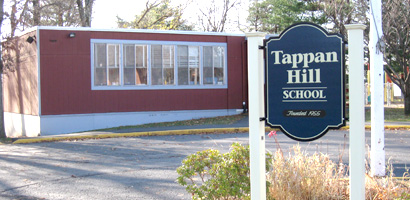 What had previously been only rumor and conjecture took a huge step towards reality on Thursday, March 4th, when Tarrytown Superintendent Howard Smith officially recommended that the Board of Education close Tappan Hill School for the upcoming 2010-11 school year.
What had previously been only rumor and conjecture took a huge step towards reality on Thursday, March 4th, when Tarrytown Superintendent Howard Smith officially recommended that the Board of Education close Tappan Hill School for the upcoming 2010-11 school year.
This closure would result in Pre-K and Kindergarten being housed at John Paulding, with Morse housing grades 1 and 2, and Washington Irving housing grades 3-5, becoming a three-grade school once again.
Presenting the Board of Education with his proposed budget (which can be viewed in full online at http://www.tufsd.org/) in front of over 75 parents and community members in the John Paulding multi-purpose room, Dr. Smith went step-by-step over every aspect of the decision-making process that led him to his difficult recommendation. “The overall challenge that we started with was that a business-as-usual budget would have generated a double-digit tax increase,” said Smith. Even with the savings created by closing the school, the district would still see a tax increase of 5.48% — an increase that, due to elements beyond anyone’s control, would not be distributed equally between the two villages. Rather, residents of Tarrytown would experience a 1.66% tax increase, while their neighbors to the north in Sleepy Hollow would suffer an 8.27% tax increase.
If the residents of the two villages refuse to pass the budget during the School Budget vote in May, the Board has the option to try to push through a new budget, or to run with a Contingency Budget, which would consist of all of Dr. Smith’s recommendations, plus additional cuts needed to get the budget to where it would have to be by law. These other cuts include eliminating the elementary-level foreign language program, as well as axing Middle School clubs and the Middle School summer school, and removing Ice Hockey and Swimming from the offered list of electives.
The crowd listened patiently and attentively as the case was made, keeping their emotions in check during Dr. Smith’s hour-long explanation. Dr. Smith continually expressed his own disappointment that the economic pressures have forced him to make such difficult decisions. “You don’t get into this business to do this,” he said. Unfortunately, as hard as the budget crunch is this year, next year looks to be just as difficult. “A year from now,” he said, “we’ll be back in this room facing another significant set of challenges.” With this in mind, he said, “I will be recommending, as part of my budget proposal… a study committee for next fall that deals with alternative mechanisms for financing things like sports and extra-curricular activities.”
Many people in the audience were saddened by the thought of losing Tappan Hill. The alternative, however, was not one Dr. Smith favored. “If you have to achieve the same savings without doing the building consolidation, it has more impact on our instructional programs,” he said. Instead, his proposed budget focuses on efficiency as opposed to eliminating programs. For example, the administration recently discovered that closing Tappan Hill would also allow the District to save quite a bit in transportation costs. “Having one less building created an opportunity to redesign our transportation arrangements and schedule,” he said. “If we have a separate starting and ending time for each of the three buildings, then we can transport children in three waves and only use five buses each time around when we’re currently using ten, so there’s a significant savings there. Instead of an initial first-year savings in the range of $350,000, we’re talking more like $670,000.”
If the building closure were to go through, Dr. Smith reassured the audience that steps would be taken to make age-appropriate alterations to the schools involved. “The next step in this whole process would be to put together a transition committee of parents and staff associated with each of the moves at the grade levels. They would be charged with coming up with a list of recommended accommodations at the buildings and the sites that would be responsive to the needs of the kids.” Any changes to be made would be paid for by funds remaining from an earlier school bond. “We have about a million dollars of authorized borrowing for our elementary schools that we have not yet done,” he said.
Audience reaction to Dr. Smith’s presentation was mostly civil, with many community members asking probing questions, searching for a way to save Tappan Hill. Listening to the response, what came across more than anything was just how much many parents hate the idea of first graders in Morse school. Dr. Smith acknowledged that Morse was not ideal for that age group—it was designed as a Secondary School after all — and did what he could to allay those concerns. “There are a number of accommodations that have been made over the years [to Morse],” he said, “and there will be some looking at what other kinds of reasonable accommodations can be made to address the developmental needs of first graders.”
Despite Dr. Smith’s sobering presentation, Board of Education President Mimi Goodwin reminded everyone that it was only a recommendation, and that the ultimate decision lies with the Board, not the Superintendent. “Let me just be clear to all of you,” she said. “We, as a Board, have had no discussions at all about the recommendation to close Tappan Hill. We are in the very, very beginning of this process. We invite you — we want you — to be part of this process and to walk through it with us.”
Walking through the process will entail a series of public meetings, most notably the Board meeting/work session held onThursday, March 18 at the John Paulding multi-purpose room. The meeting was to start with a complete discussion of the budget and the Tappan Hill closure, and then everyone was to be divided into smaller groups to discuss the issues and come up with ideas and proposals before gathering together once again to hear feedback.
The desire is to really get the community involved in this issue. Said Dr. Smith, “We’re trying to be very open about sharing the dilemma that we face.” His hope is that by bringing the community at large into the process, a course of action can be determined that, while not ideal, is something that all parties involved — administration, faculty, parents, and community members — can rally around to provide the best education to the district’s students.






